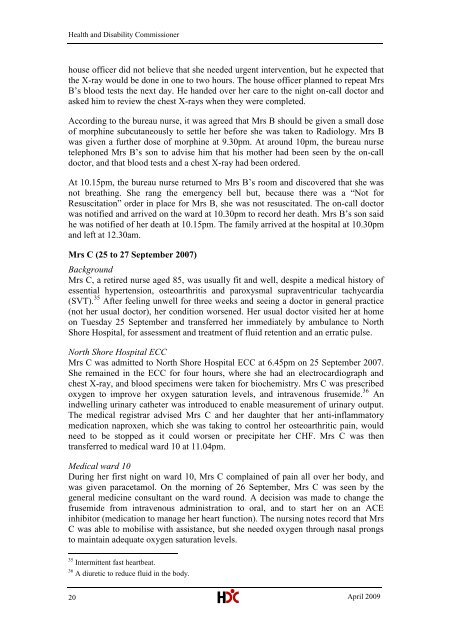North Shore Hospital report - New Zealand Doctor
North Shore Hospital report - New Zealand Doctor
North Shore Hospital report - New Zealand Doctor
You also want an ePaper? Increase the reach of your titles
YUMPU automatically turns print PDFs into web optimized ePapers that Google loves.
Health and Disability Commissionerhouse officer did not believe that she needed urgent intervention, but he expected thatthe X-ray would be done in one to two hours. The house officer planned to repeat MrsB‘s blood tests the next day. He handed over her care to the night on-call doctor andasked him to review the chest X-rays when they were completed.According to the bureau nurse, it was agreed that Mrs B should be given a small doseof morphine subcutaneously to settle her before she was taken to Radiology. Mrs Bwas given a further dose of morphine at 9.30pm. At around 10pm, the bureau nursetelephoned Mrs B‘s son to advise him that his mother had been seen by the on-calldoctor, and that blood tests and a chest X-ray had been ordered.At 10.15pm, the bureau nurse returned to Mrs B‘s room and discovered that she wasnot breathing. She rang the emergency bell but, because there was a ―Not forResuscitation‖ order in place for Mrs B, she was not resuscitated. The on-call doctorwas notified and arrived on the ward at 10.30pm to record her death. Mrs B‘s son saidhe was notified of her death at 10.15pm. The family arrived at the hospital at 10.30pmand left at 12.30am.Mrs C (25 to 27 September 2007)BackgroundMrs C, a retired nurse aged 85, was usually fit and well, despite a medical history ofessential hypertension, osteoarthritis and paroxysmal supraventricular tachycardia(SVT). 35 After feeling unwell for three weeks and seeing a doctor in general practice(not her usual doctor), her condition worsened. Her usual doctor visited her at homeon Tuesday 25 September and transferred her immediately by ambulance to <strong>North</strong><strong>Shore</strong> <strong>Hospital</strong>, for assessment and treatment of fluid retention and an erratic pulse.<strong>North</strong> <strong>Shore</strong> <strong>Hospital</strong> ECCMrs C was admitted to <strong>North</strong> <strong>Shore</strong> <strong>Hospital</strong> ECC at 6.45pm on 25 September 2007.She remained in the ECC for four hours, where she had an electrocardiograph andchest X-ray, and blood specimens were taken for biochemistry. Mrs C was prescribedoxygen to improve her oxygen saturation levels, and intravenous frusemide. 36 Anindwelling urinary catheter was introduced to enable measurement of urinary output.The medical registrar advised Mrs C and her daughter that her anti-inflammatorymedication naproxen, which she was taking to control her osteoarthritic pain, wouldneed to be stopped as it could worsen or precipitate her CHF. Mrs C was thentransferred to medical ward 10 at 11.04pm.Medical ward 10During her first night on ward 10, Mrs C complained of pain all over her body, andwas given paracetamol. On the morning of 26 September, Mrs C was seen by thegeneral medicine consultant on the ward round. A decision was made to change thefrusemide from intravenous administration to oral, and to start her on an ACEinhibitor (medication to manage her heart function). The nursing notes record that MrsC was able to mobilise with assistance, but she needed oxygen through nasal prongsto maintain adequate oxygen saturation levels.35 Intermittent fast heartbeat.36 A diuretic to reduce fluid in the body.20April 2009
















